Population growth, energy use, and environmental impact: Comparing the Canadian and Swedish records on CO2 emissions
DOI:
https://doi.org/10.25336/P6W905Keywords:
population, environment, energy, CO2 emissions, greenhouse gasesAbstract
There are many similarities between Canada and Sweden, as both are relatively affluent northern nations with diverse modern economies. Both have witnessed demographic growth and climbing affluence, with predominantly export-oriented economies. Yet in terms of their respective records on greenhouse gas emissions, there is a stark contrast between the two. Sweden is often considered a world leader in reducing emissions, whereas Canada has been widely criticized for its failure to meet international commitments. The current paper attempts to delineate some of the factors responsible for the observed differences between the two countries. It examines trends in environmental impact (CO2 levels) by applying a modified and updated version of Ehrlich’s IPAT equation. The crux of the matter in comparing the two countries is Canada’s substantial population growth and heavy demand for energy (29th among 30 countries in the OECD on our measure of energy intensity) whereas Sweden has managed to move away from fossil fuels in driving its economic activity.Downloads
Published
Issue
Section
License
Copyright (c) 2019 Don Kerr

This work is licensed under a Creative Commons Attribution 4.0 International License.
The following copyright statement applies to content published in Volumes 1 - 45 of Canadian Studies in Population.
Authors retain copyright and grant the journal right of first publication with the work simultaneously licensed under a Creative Commons Attribution License that allows others to share the work with an acknowledgement of the work's authorship and initial publication in this journal.
Authors are able to enter into separate, additional contractual arrangements for the non-exclusive distribution of the journal's published version of the work (e.g., post it to an institutional repository or publish it in a book), with an acknowledgement of its initial publication in this journal.
Authors are permitted and encouraged to post their work online (e.g., in institutional repositories or on their website) prior to and during the submission process, as it can lead to productive exchanges, as well as earlier and greater citation of published work (See The Effect of Open Access).



